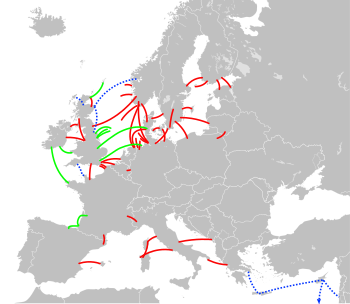| Part of a series on |
| Power engineering |
|---|
| Electric power conversion |
| Electric power infrastructure |
| Electric power systems components |
An interconnector (also known as a DC tie in the USA) is a structure which enables high voltage DC electricity to flow between electrical grids. An electrical interconnector allows electricity to flow between separate AC networks, or to link synchronous grids. They can be formed of submarine power cables or underground power cables or overhead power lines.
The longest interconnection as of July 2022 was the 2,210 km Hami - Zhengzhou delivering 8 GW of high voltage direct current power. The longest proposed connector is the 3,800 km, 3.6 GW Xlinks Morocco-UK Power Project.
Economy
Interconnectors allow the trading of electricity between territories. For example, the East–West Interconnector allows the trading of electricity between Great Britain and Ireland. A territory which generates more energy than it requires for its own activities can therefore sell surplus energy to a neighbouring territory.
Interconnectors also provide increased resilience. Within the European Union there is a movement towards a single market for energy, which makes interconnectors viable. They are essential to achieve security of supply. As such, the Nordic and Baltic energy exchange Nord Pool Spot rely on multiple interconnectors. The fullest possible implementation of this is the proposed European super grid which would include numerous interconnectors between national networks.
Interconnectors are used to increase the security of the energy supply and to manage peak demand. They enable cross-border access to the producers and consumers of electricity, thus increasing the competition in energy markets. They also help integrate more electricity generated from renewable sources, thus reducing the use of fossil fuel power plants and CO2 emissions. Interconnectors aid adaptation to changing demand patterns such as the uptake of electric vehicles.
Infrastructure

Interconnectors may run across a land border or connect two land areas separated by water. As of July 2022 there are at least 35 international connectors and many more intra-national connectors, see high-voltage direct-current (HVDC) projects.
See also
- List of high-voltage direct-current (HVDC) projects
- Variable-frequency transformer
- Solid-state transformer
References
- "CONNECTING THE GRID: DC TIES SERVE CRITICAL ROLE". www.nmppenergy.org. Retrieved 2022-11-27.
- Electricity interconnectors ofgem
- LARGE-SCALE ELECTRICITY INTERCONNECTION 2016
- "The Morocco - UK Power Project". xlinks.co. Retrieved 3 July 2022.
- European Commission, http://ec.europa.eu/energy/gas_electricity/internal_market_en.htm
- "European Electricity Review 2023". Ember. 2023-01-31. Retrieved 2023-02-02.
- GB/France : un projet d’interconnexion dans les tuyaux... de la justice, www.lemondedelenergie.com